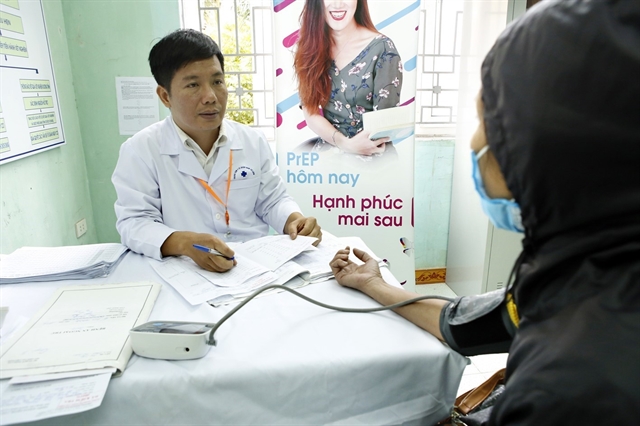 Society
Society

 |
| An HIV-infected patient is consulted on treatment. — VNA/VNS Photo Dương Ngọc |
HÀ NỘI — The People’s Committee of Hà Nội has set up a plan of HIV/AIDS prevention and control in the city by the year 2030.
The plan, known as 55/KH-UBND dated February 20, aims to reach the goal of reducing the number of new HIV infections and AIDS-related deaths and end the AIDS epidemic in the city by 2030 as well as minimise the impact of the HIV/AIDS epidemic on socio-economic development.
According to the plan, this year, the city strives for 90 per cent of people living with HIV will know their HIV infection status while 90 per cent of people living with HIV on the management list are treated with anti-retroviral (ARV) drugs and 98 per cent of patients on ARV have an HIV viral load below the suppression threshold.
The plan also sets out specific targets that this year 500 new HIV infections will be detected, 80 per cent of drug addicts will have access to a needle and syringe programme, 65 per cent of female prostitutes will have access to a condom programme, and 65 per cent of men who have sex with men (MSM) will have access to a condom and lubricant programme.
Under the plan, the health care sector will complete 300 key monitoring samples as prescribed by the Ministry of Health, and ensure 14,350 people living with HIV/AIDS will maintain on antiretroviral therapy while 633 HIV-infected people will start antiretroviral therapy, and 11,112 people living with HIV/AIDS who are on ARV will be tested for HIV load in monitoring ARV.
To achieve the above objectives, the municipal People's Committee proposed three groups of solutions including prevention and harm reduction interventions; HIV/AIDS testing and surveillance; and treatment and care for people living with HIV.
Specifically, for the solution of prevention and harm reduction interventions, the city will improve the quality of information, education and communication work; reduce stigma and discrimination related to HIV; and expand and renew interventions to reduce harm and prevent HIV infection.
Regarding testing and surveillance, the health care sector must increase HIV testing counselling, diversify HIV testing and counselling services, promote HIV testing in grass-roots health facilities, expand testing in the community and mobile testing and self-testing at home.
It is necessary to strengthen co-operation with projects and NGOs to implement testing activity and HIV detection in the community.
In addition, the city will enhance the sharing and use of data in HIV/AIDS prevention and control and establish systems of case monitoring from HIV infection to treatment participation, treatment facility transfer, treatment quality, and treatment adherence for each HIV-infected person.
HIV infected persons will be treated with ARVs as soon as they are diagnosed.
HIV/AIDS treatment in prisons and drug rehabilitation establishments will be maintained while HIV pre-exposure prophylaxis (PrEP) treatment will be provided to those who are at risk of HIV infection.
The committee asked the health department and relevant offices of all districts and communes to set key targets for the implementation of the HIV/AIDS prevention and control plan in 2023.
Moreover, it is necessary to accelerate the work of education and dissemination on HIV/AIDS prevention and control. Accordingly, civil servants and public employees should actively approach and mobilise relatives and friends, especially those at high-risk of being infected with HIV to test and access consultation and treatment.
The people's committees of districts, communes and towns shall develop plans and monitor, inspect, and assign targets for the implementation of the city’s HIV/AIDS prevention and control plan in 2023. — VNS




